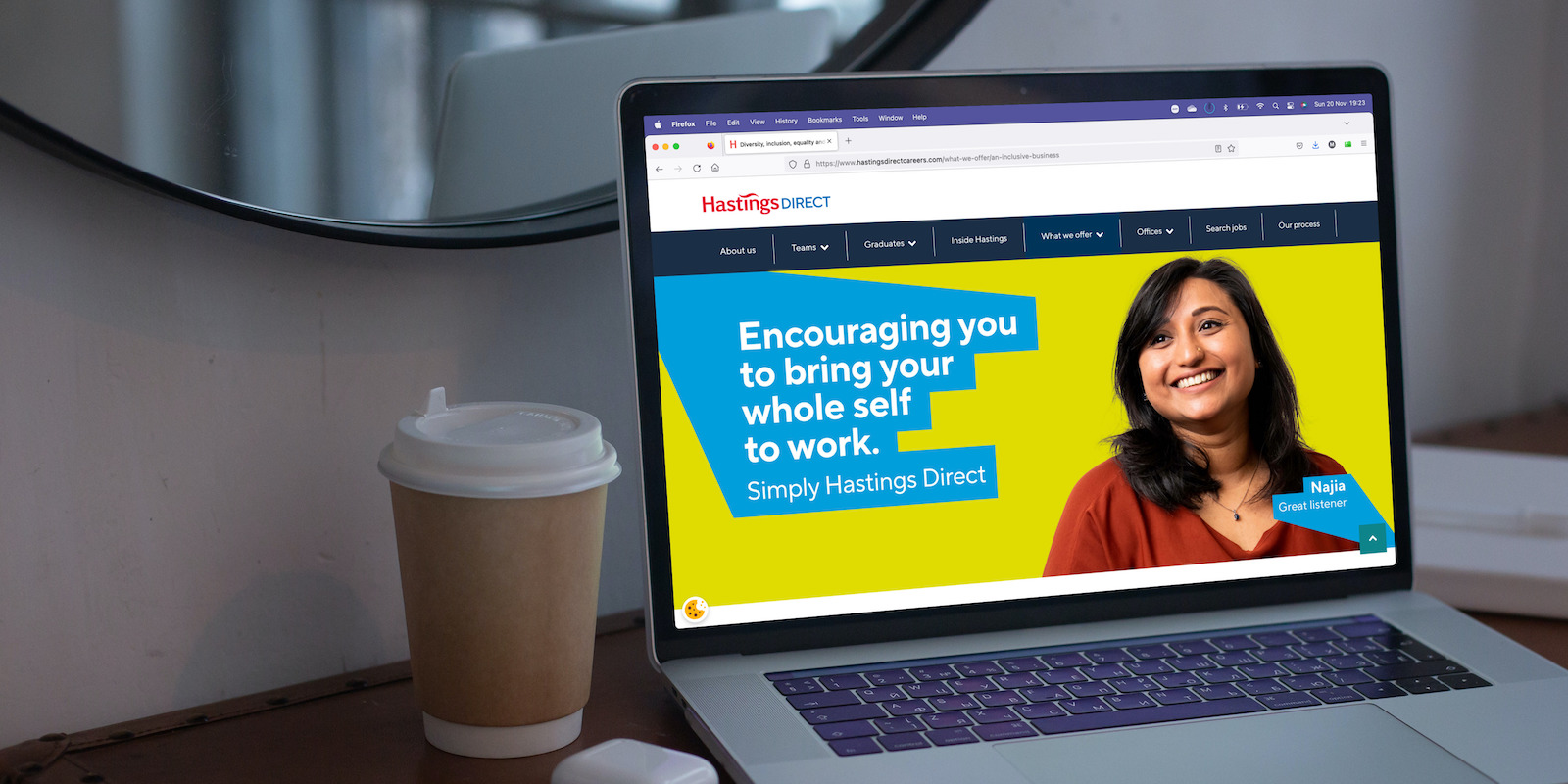We all want to feel welcome and included. It’s a fact of life. We are attracted to people we feel comfortable with, who are like us. It helps us trust them more too, if we feel they’ll accept us as we are and treat us fairly. The same applies to where we work. That’s why being an organisation that embraces and communicates Diversity, Equity and Inclusion (DE&I) is so important.
Everyone working in talent acquisition, resourcing and recruitment knows this of course – and many are building organisations with much more of an inclusive appeal. The challenge they have is often how to show the progress they’ve made, how to tell the stories that reflect true Diversity, Equity and Inclusion in their employer brand messaging.
That’s why we’ve written this little blog. We’ve worked with a number of clients, helping them showcase stories that emphasise Diversity, Equity and Inclusion in many different ways. What we’ll cover are all things we think you could feature in your employer branding and careers websites. But first, as these stats show, it’s also what your candidates would like to see too.
A few stats you’ll want to know
We aren’t featuring these to put the business case for Diversity, Equity and Inclusion. There’s no need to argue why doing the right thing is a good business strategy. But they do show just how important it is to the people you want to recruit and retain. After all, they are the customers of your employer brand and they’ll tune out if they can’t find what they are looking for.
So, what do they think about Diversity, Equity and Inclusion? Glassdoor did a Diversity Hiring Survey in 2020 and found that:
- More than 3 out of 4 job seekers and employees (76%) report that a diverse workforce is an important factor when evaluating companies and job offers.
- Nearly a third of employees and job seekers (32%) would not apply to a job at a company where there is a lack of diversity among its workforce. This percentage was considerably higher for black and LGBTQ jobseekers.
- 50% of current employees want their workplace to do more to increase diversity.
So there you have it. Not communicating the Diversity, Equity and Inclusion elements of your workplace will in all likelihood deter talent from feeling you are the right place for them.
Diversity, Equity and Inclusion – how the CIPD define it
It’s always helpful to have a definition from an authority source and, although most people have a good idea of what the terms mean, we like the clarity that the CIPD bring.
- Diversity recognises that, though people have things in common with each other, they are also different many ways.
- Equality ensures that every individual has equal opportunities, regardless of their background, identity or experience.
- Inclusion is where those differences are seen as a benefit, and where perspectives and differences are shared, leading to better decisions.
Some tactics to embed and communicate DE&I
Get your leaders on-board
What leaders think, and the causes they support and care about get noticed. A leader that’s engaged with an issue can turn a difficult topic in to a cause people will rally around. If it wasn’t for leaders being more open about mental health and wellbeing, we wouldn’t have seen the progress made in making employee welfare a mainstream topic, particularly post-pandemic. Likewise, when Sir Richard Branson champions Dyslexia and Neurodiversity, people notice and by association, that reflects favourably on the Virgin employer brand. Diversity, Equity and Inclusion is no different. Whether it’s from your C-Suite or within your HR or People function, getting behind Diversity, Equity and Inclusion through support, promotion and involvement of leaders will elevate the visibility of what you are doing and encourage engagement.
HR and marketing should work together
There’s always that internal debate about who ‘owns’ the employer brand, marketing or HR. Certainly we’ve seen marketing becoming more interested in the value of the employer brand. I presented at the recent Building Brands UK Marketing Conference to an audience of marketers interested in the EVP and employer branding. In the case of DE&I, HR will be working on the policies that support the principles of Diversity, Equity and Inclusion and marketing have an interest in broader communication so that customers (including those of the employer brand), see that the organisation represents them.
Let your people tell their stories
There are two reasons why this is a powerful idea. Nothing is as convincing as your own people bringing to life their own experiences of working for you. If you reflect a diverse group of people, all talking about the work they do, it won’t only attract candidates, it will say a lot about your culture and will help people feel they could belong. The other reason is candidates are most likely to trust stories from people they identify with who are like them. You might focus on individuals and the jobs they do, or you could decide to showcase how you support an issue. For example, our client, NFU Mutual, wanted to increase the number of women in senior management, so they created their Women in Finance Charter. We supported this by profiling stories of women managers, like this one for Alvyda on the NFU Mutual careers blog.
Be authentic in your imagery and video
One of the best and fastest ways to represent diversity is to reflect it on your careers website. And featuring your own people is the most authentic way to deliver this. Part of the brief for the careers website we produced for Derbyshire Constabulary was to reflect the culture of the organisation and better represent the groups within it. Everyone featured on the website and recruitment communications is a real employee and this has helped to change the way that people see the force as an employer. For people to feel like they could be comfortable in your organisation, your recruitment communications need to reflect people like them. For example, Hastings Direct have an office in Leicester, a city famous for it’s strong Asian and Black communities, so it was essential that their website reflected this with a strong presence from their Asian and Black colleagues.
Don’t forget the candidate experience
Remember that the Glassdoor findings were largely about how DE&I influenced candidates’ engagement in the recruitment process. So, to incorporate Diversity, Equity and Inclusion into your employer brand, consider how you are demonstrating your initiatives across every aspect of the candidate experience – and remember that candidates can drop off at any point along the way.
Ask yourself, are your recruiters and line managers able to interview without bias and are they aware of reasonable adjustments some candidates may need? It might help if they are trained in issues such as unconscious bias. Do you track the diversity and gender of applicants so you can see if you lose any disproportionately in the process? And are you able to accommodate neurodiverse candidates who may have different needs in the way they are interviewed? These are just a few examples of how awareness of Diversity, Equity and Inclusion can turn into actions that create perceptions of a fairer recruitment process – and a more welcoming workplace.
In conclusion
There’s one final stat that underpins all of this. Although we said we don’t need to put a business case for Diversity, Equity and Inclusion, a well-known piece of research by McKinsey found that organisations with ethnically or gender-diverse leadership teams are more likely to outperform others by 25% and 36% respectively. The more you reflect DE&I in your employer brand and attract more diverse talent, the stronger and more profitable your organisation will become. It’s not only the right thing to create a culture where your people feel included and see themselves, your employer brand is the key to attracting the diversity of talent needed to thrive in the long-term.
Need a little help?
If you feel that you’d like some help, support or even a little chat around LinkedIn or any aspect of your employer brand and talent attraction strategy just drop us a line. After all, much of our best work has started with a cup of tea and a Zoom call.


